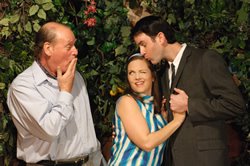
From its very first performance, several strange events have plagued Shakespeare's famous yet short play, Macbeth, a play that was supposedly written to please King James. It is said that practitioners of the black magic ritual depicted in Act 2 took exception to the exposure of their witchcraft and cast a spell on the play. There are instances of terrible consequences (or coincidences) which have befallen those connected with the play and it has become bad luck to even say the word “macbeth” in a theater, unless it is part of the script. There are complicated rituals involved with removing the curse should one forget and utter the word. Superstition is so strong that for many theater people, it is known simply as “The Scottish play,” to avoid saying the cursed word.
The cast of the UC Department of Theater and Dance’s current performance of the Scottish play must have been very diligent to limit their references to the title character to on-stage utterances, because there is nothing “bad luck” about this production, directed by MFA candidate Emily Davis, a production which ignores gender in the casting of the play (the majority of the roles are played by women) and concentrates instead on the best performances of its 15 person ensemble.
The Wyatt Pavilion does not lend itself easily to elaborate sets, but scenic designer Robert Broadfoot has worked miracles with twigs, giving one the sense of being in a forest. (He has designed a particularly interesting looking dining table and stools)
Costume Designer, Molly LeGoy, in conjunction with director Davis, has created an interesting look for the three witches. They appear at the start of the play, joined together to form a barren tree, their body suits show the bark of the tree, the branches are extensions of their fingers. Throughout the play, they break apart or come together, as the case warrants.
Art Grueneberger has added an interesting twist with “puppet elements” as part of the witches’ cauldron scene in Act 2.
Heading the cast are Paula Dawson as Macbeth and Ara Glenn-Johanson as Lady Macbeth (repeating a performance of the role she last did in the 5th grade).
Dawson has mastered the manly swagger, has a throaty voice, and she brings believability to the complexities of Macbeth’s personality, at the same time hungry for power, and wracked with guilt over what he does to obtain it. We watch Macbeth’s rapid transformation from an opportunist to someone who has destroyed himself and everything around him in his quest for power.
Glenn-Johanson is simply marvelous as Lady Macbeth, from the moment she reads her husband’s letter hinting at future greatness based on the prophesies of the three witches. She knows how to push her husband to grab the crown, and how to help him deal with what he must do to get it. “Leave the rest to me,” she tells her husband, taking charge of the plans for what must occur. We later watch her descent into madness as she comes to the realization that crime really doesn’t pay.
Travis Dukelow is a regal and likeable Duncan, who will meet a tragic end. Dukelow also appears in 3 other roles.
Sarah Cohen has an appropriate princely bearing as Malcolm, especially at the conclusion of the play when Malcolm assumes the crown following the death of Madbeth.
Jon Carlo Blumwald wields a mean sword, especially as he slays Macbeth.
All of the swordplay is quite realistic, thanks to the fight choreography of Gregory Hoffman, and the cast wield their huge, heavy swords expertly. The fight scenes make the most use of all of the stage and ramp areas of Wyatt Pavilion to good effect.
JT Reece offers comic relief as the Porter, clowning with members of the audience (even a dense reviewer who didn’t realize she was being asked to tie his shoe for him).
Andrea Guidry is particularly good as Lennox, and Franchesca Jimenez is a sensitive Banquo.
Shefali Nagrani has two small roles, as a gentlewoman and as Fleance and yet she makes an impact whenever she is on the stage.
This Macbeth is one worth checking out. It is a tale told in a manner which will appeal to both the die-hard Bard afficionados and yet not so stylized or esoteric that it becomes difficult for the neophyte to enjoy.




